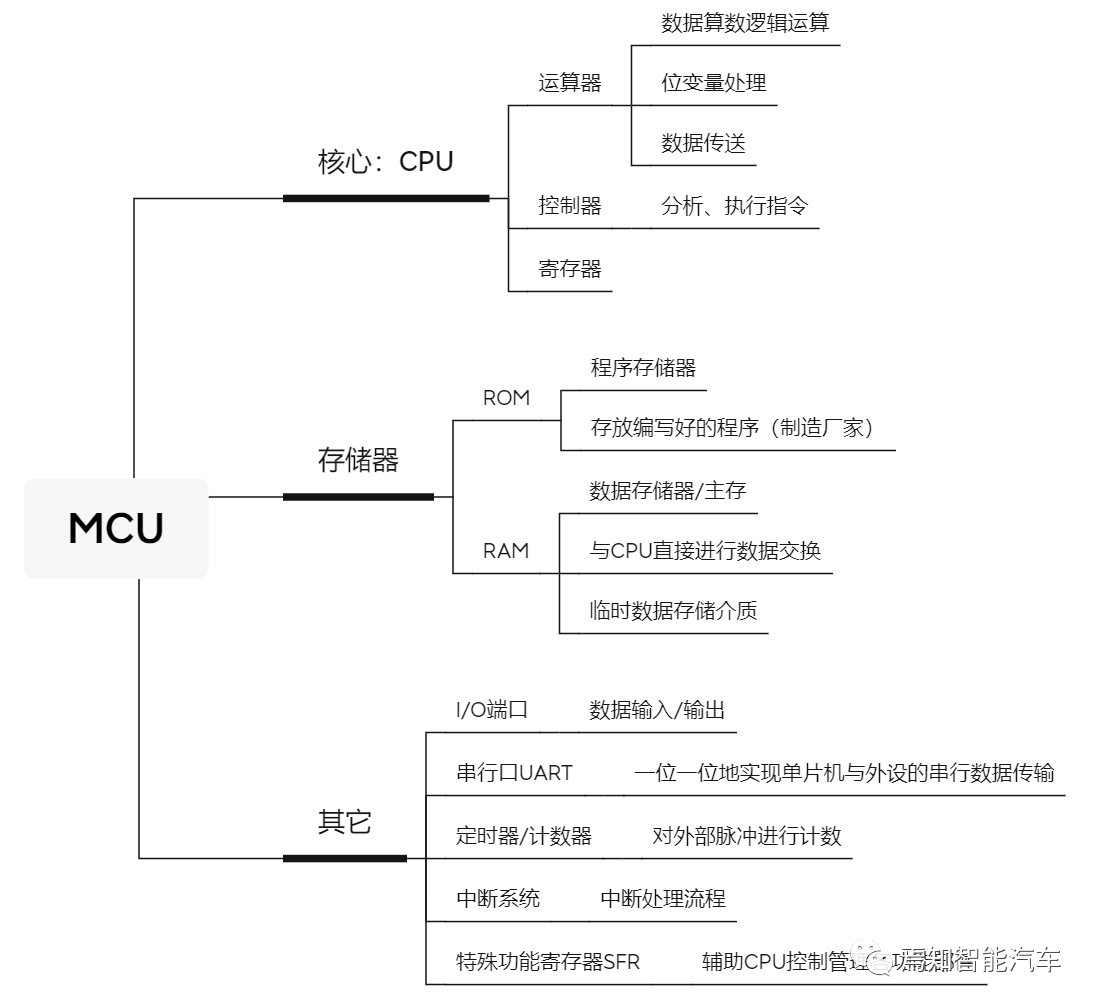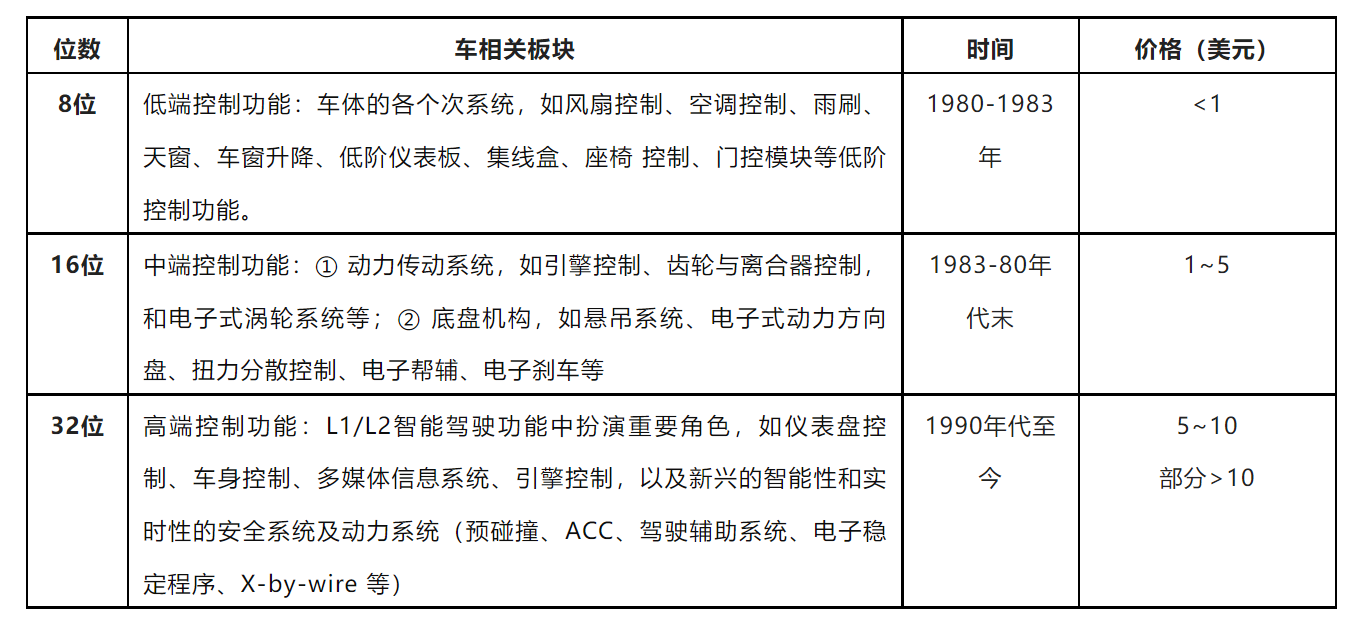MCU Structure
MCU, or Microcontroller Unit, is a chip-level computer that integrates CPU, memory, peripheral functions into a single chip with control functions, mainly used for signal processing and control. It is the core of intelligent control systems and is closely related to our daily life and work such as automotive electronics, industry, computer networking, consumer electronics, home appliances, and IoT, where the automotive electronics market is the largest, occupying 33% of the global market.
MCU Components
MCU mainly consists of the central processing unit (CPU), memory (ROM and RAM), input/output (I/O) interface, serial port, counter and other components.

- CPU: Central Processing Unit, the core component of MCU that can perform arithmetic and logical operations, bit variable handling, and data transfer operations, while the control unit coordinates and executes instructions according to a certain timing sequence.
- ROM: Read-Only Memory, the program memory that stores programs written by the manufacturer. The information is read in a non-destructive way, and the stored data does not disappear after power-off. The MCU executes the pre-written program.
- RAM: Random Access Memory, the data memory that directly exchanges data with the CPU. The data cannot be preserved after power-off. It can be written and read out at any time during program execution and is usually used as temporary data storage for operating systems or other running programs.The Relationship between CPU and MCU:
CPU is the core of arithmetic operation and control. In addition to CPU, MCU contains ROM or RAM, making it a chip-level chip. Another common type is SoC (System on Chip), which is a system-level chip capable of storing and running system-level codes, such as QNX, Linux, and others. It contains multiple processing units (CPU+GPU+DSP+NPU + storage + interface unit).
The Bit Number of MCU
The bit number refers to the data processing width of MCU. The higher the bit number, the stronger the data processing capability of MCU. Currently, there are mainly three types of bit numbers: 8, 16, and 32, among which 32-bit accounts for the highest proportion and grows rapidly.

In automotive electronic applications, 8-bit MCUs are low-cost and easy to develop, mainly used in relatively simple control fields, such as lighting, wiper, window, seat, and door controls. For relatively complex fields, such as instrument displays, in-vehicle entertainment information systems, power control systems, chassis, driving assistance systems, etc., 32-bit MCUs are mainly used, and the requirement for MCU computational capability is getting higher with the iteration and evolution of automotive electrification, intelligence, and networking.

MCU Vehicle Certification
MCU suppliers usually need to complete three major certifications before entering OEM’s supply chain system: in the design stage, they need to follow the functional safety standard ISO 26262; in the chip-making and packaging stage, they need to follow AEC-Q001~004 and IATF16949; and in the certification and testing stage, they need to follow AEC-Q100/Q104.ISO 26262 defines four safety levels known as ASIL, from low to high: A, B, C, and D; AEC-Q100 comprises four reliability levels, from low to high: 3, 2, 1, and 0. Certification of AEC-Q100 series generally takes 1-2 years, whereas certification of ISO 26262 is more challenging and takes longer.
Application of MCU in the Smart Electric Vehicle Industry
MCUs are widely used in the automotive industry, covering areas such as the body accessories, powertrain systems, chassis, car entertainment systems, and intelligent driving. With the development of the smart electric vehicle era, there is an increasing demand for MCU products.
Electrification:
-
Battery Management System BMS: A MCU is required for the main controller and each sub-controller to manage charge and discharge, temperature, and battery inter-balance.
-
Vehicle Control Unit VCU: An electric vehicle energy management system requires an additional VCU fitted with a 32-bit high-performance MCU. The number of units varies according to different factory plans.
-
Engine Controller / Transmission Controller: In order to replace engines from traditional cars, the inverter control MCU for electric vehicles needs to replace the gas car’s engine controller. As the motor speed is high and needs to be slowed down by the reducer, the chip control of the MCU equipped has replaced the gas car’s transmission controller.
Intelligence:
-
Currently, the domestic automotive market is still in the stage of high-speed penetration (L2), and the consideration of comprehensive cost and performance for OEM new ADAS features still uses a distributed architecture. With the increase of load rate, more MCUs are required to process sensor information.
-
With the increasing functionality in cockpit, the role of chips with higher new energy efficiency is becoming increasingly important, resulting in a slightly reduced status for corresponding MCUs.
Manufacturing Process
MCUs themselves prioritize computational power and do not require advanced process technology. Furthermore, their built-in embedded storage limits the expansion of MCU process technology. For this reason, the current mainstream process nodes for automotive MCUs are mature process technology including 40nm and above, while some advanced car MCU products utilize 28nm process technology. The specification for automobile chips is primarily 8-inch wafers, with some manufacturers, particularly IDMs, beginning to migrate towards 12-inch platforms.
Currently, 28nm and 40nm process technology are the market mainstreams.### Typical Enterprises at Home and Abroad
Compared with consumer and industrial grade MCUs, automotive grade MCUs have higher requirements for operating environment, reliability, and supply cycle. In addition, automotive grade MCU certification has a relatively high threshold, with a long certification time and a high entry difficulty. Therefore, the overall MCU market structure is relatively concentrated, with the top five MCU companies in the world accounting for as much as 82% in 2021.

Currently, China’s automotive grade MCUs are still in the import period, and there is huge potential for the localization of the supply chain and the substitution of domestic products.

This article is a translation by ChatGPT of a Chinese report from 42HOW. If you have any questions about it, please email bd@42how.com.
